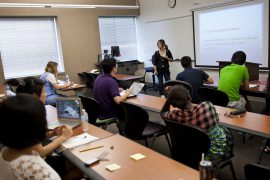Have you ever wondered what it is like for autistic academics to navigate a sensory-rich campus? In academia, individuals must navigate diverse physical and social environments, including bustling classrooms, meeting rooms filled with social interactions, and offices where concentration can waver due to distractions from colleagues, students, and administration.
Imagine standing in a room where the light is glaring, colours are agitating, and patterns are clashing. You can’t ignore the background hum of the air conditioning or the buzz of fluorescent lights. An audience sits before you, many of whom have travelled far to hear your insights. Will you manage to focus on your presentation while your mind is swirling from the sensory overload? This experience is all too familiar for many autistic academics.
According to the WHO (World Health Organization, 2010), a healthy workplace is an environment where employees can experience holistic physical, mental, and social well-being. The built environment significantly impacts individuals’ well-being through communicating sensory information that needs to be processed by the human brain. However, autistic individuals are usually characterised by an increased sensitivity to stimuli. They are more likely to experience sensory overload in hectic environments like busy university settings. Different stimuli that usually occur in such environments, including noise, bright light, movement, and social interaction, are usually overwhelming and distracting for autistic individuals, hindering their ability to concentrate and engage in daily activities.
The value of autistic academics
Academia presents a unique advantage for individuals on the autism spectrum. It allows them to build careers around their specific interests and expertise, perfectly aligning with their strengths. Autistic academics bring invaluable insights and a firsthand understanding of the challenges and opportunities in educational settings. Their exceptional skills—like attention to detail, strong memory, and logical thinking, highlighted by research from Cope and Remington (2022)—enhance academic environments, especially at top-ranking universities like the University of Sydney. Here, autistic academics not only contribute their knowledge but also foster inclusive learning spaces that benefit all students. As Sandra Thom-Jones, an autistic professor at the University of Wollongong, says:
Maybe we don’t know all the right words to say and we don’t always have the right facial expressions, and we might not be all smiley and touchy-feely, but I tell you that if you’ve got an autistic nurse, teacher or doctor, they will go over and above to make sure you get the best outcome and the best solution because they will want you to do well and achieve.
In the vein of acknowledging personal stories, think about Temple Grandin. Her journey as an animal behaviourist and academic exemplifies the strengths of autistic individuals in academia. She challenges us to view autism not as a disability but as a unique perspective that fosters diversity:
The world needs all types of minds.
Grandin urges us to recognise and celebrate the unique contributions of autistic individuals in academia, highlighting how diverse thinking can drive innovation and resilience.
Insights from autistic academics
While research on inclusive learning environments for autism is expanding, it often centres on children or students rather than autistic academics (Wood & Happé, 2023). Understanding the lived experiences of autistic staff is crucial for designing genuinely inclusive higher education environments.
Imagine navigating our campus for the first time: you walk across the uneven cobblestones of Eastern Avenue, where the sounds of passing students and construction mix in an overwhelming symphony. You might find the bright sunlight reflecting off the glass buildings disorienting, making it hard to concentrate on your thoughts. This sensory experience could be daunting for an autistic educator trying to find their footing in this bustling atmosphere.
As we reflect on how to create a more inclusive campus, consider these practical steps:
- Design with sensory considerations: Use calming colours, implement noise-reducing strategies, and provide adjustable lighting to minimize distractions. Also, create quiet rooms for staff to retreat to during overwhelming moments.
- Flexible workspaces: Design work areas that allow for personal adjustments, such as lighting and seating arrangements.
- Training sessions: Offer workshops to increase awareness about neurodiversity among faculty and staff.
- Feedback channels: Establish avenues for autistic individuals to share their experiences and suggestions for improvement, making them feel heard and valued in the academic community.
- Share your suggestions: if you have any ideas on how to improve the University’s classroom environment for teaching staff with disabilities share them with the DIAP.
- Connect: with other academics and teaching staff with disabilities by joining the University’s Disability At Work Network (DAWN).
- Support research funding: Provide access to funding for projects on neurodiversity and inclusive design to foster innovation and inclusivity.
- Collaborative research initiatives: Promote collaborative research initiatives involving academics with diverse backgrounds and expertise, fostering a multidisciplinary approach to addressing challenges related to neurodiversity in academia.
As a first year doctoral candidate at the School of Architecture, Design, and Planning, I am focusing my research on autism and neuro-inclusive design for my thesis titled “Navigating Neurodiversity: Understanding the Campus Environment Through the Eyes of Autistic Academics”, which emphasises the need for ongoing progress. Despite the strides made, we still have much to learn. I don’t have all the answers, but let’s find them together. How can we cultivate an environment where every academic feels valued and supported? Let’s reflect on this question and take steps toward a more inclusive future.





